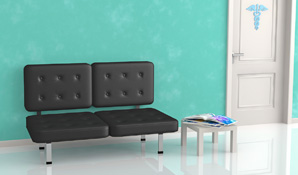If you spend more than three consecutive hours of your day looking at a computer screen, chances are that you have a condition called computer vision syndrome or CVS. In fact, studies have shown that between 80% and 90% of regular computer users have this eye problem. Fortunately, CVS is easy to treat. Unfortunately, the treatment requires that you stop spending so much time on the computer. Since for most of us, this isn’t an option, we looked into what CVS is and how it can be reduced or avoided.
What is CVS?Computer vision syndrome is a collection of eye or vision symptoms that result from spending too much time looking at a computer, tablet or even your smartphone. If these symptoms are left untreated, they can cause a deterioration in work performance and a reduction in your general sense of wellbeing. The symptoms that collectively fall under this definition include:
- Blurred vision
- Double vision
- Dry, red eyes
- Eye irritation
- Headaches
- Neck or back pain
- Dizziness or vertigo
How is CVS identified? CVS is diagnosed through a comprehensive eye examination, with the optician or optometrist taking into consideration the fact that the patient spends a great deal of time in front of a screen. It is important for the eye specialist to take a full history, including environmental factors, health problems or medication taken to eliminate any other causes of symptoms such as headaches or dry eyes.
Then a full eye test should be carried out to assess whether any existing vision problems like far-sightedness are contributing to or exacerbating the CVS. The test should include visual acuity measurements, a refraction to determine if a lens is needed to correct a vision problem, and a test to assess how well the eyes work together.
How is CVS treated? There is no evidence of long-term eye damage as the result of CVS. However, ongoing, short-term discomfort and pain can have a severe impact on your quality of life and work. And since most jobs and lifestyles these days incorporate some form of screen time, the chances of your symptoms going away on their own are very slim.
Depending on the combination and severity of your symptoms, your eye specialist will offer different treatment options. If you have a vision problem that requires correction, you will probably be told to get prescription lenses. In some cases, patients may require a programme of vision therapy to address problems that can’t be solved by glasses. Vision therapy or visual training is a programme of exercises for your eyes that improves your visual abilities. However, in most cases, you will be given some guidelines for reducing the ongoing strain that results in CVS.
How can CVS be avoided or reduced? Although specific vision problems that work in tandem with CVS need to be identified and treated, the best way to reduce the impact that CVS has on your life is to address the cause by adjusting certain screen and seating settings, and addressing other environmental factors:
- Reduce the glare on your screen
Check the lighting in the room that you work in and make sure that your screen isn’t reflecting a light or a window behind you. Make what adjustments you can to the sources of light, and if that doesn’t reduce the reflections, you can place a glare filter over your screen.
- Adjust your computer settings to suit you
Adjust the brightness, contrast and font size and colour on your screen until you find the settings that are the most comfortable for you. You might need a trial run with certain settings as there isn’t a standard recipe for reducing eye strain.
- Rearrange your desk
The best position for your monitor is slightly below eye level and between 50cm to 100cm away from your face. If you need to refer to printed material while you work on your computer, get a clip or a stand so that you are maintaining a similar focal length when you look away from your screen at the material.
- Blink often
When you look at the computer screen intently, you may forget to blink regularly. Make a point of blinking often, hard and long to help keep your eyes moist. If you are really struggling with dry eyes, find a brand of saline drops with no added chemicals that you can use regularly without side effects. And remember that a fan, heater or air-conditioning unit could also be contributing to the dehydration of your eyes.
- Rest often
One of the standard recommendations for dealing with CVS is to use the “20 20 20 rule” – every 2 minutes, focus on an object 20 feet (six metres) away, for 20 seconds. A simpler version of the rule says that sufferers should close their eyes for 20 seconds or take a 20-second look at an object outside their windows at least every half an hour.
Take care of your eyes Your eyes are your windows to the world and it is important that you look after your vision. If you are experiencing any of the symptoms of CVS, contact an optometrist or an optician right away. It could make a huge difference to how you see the world.




